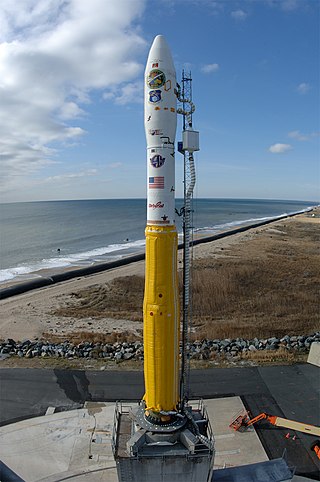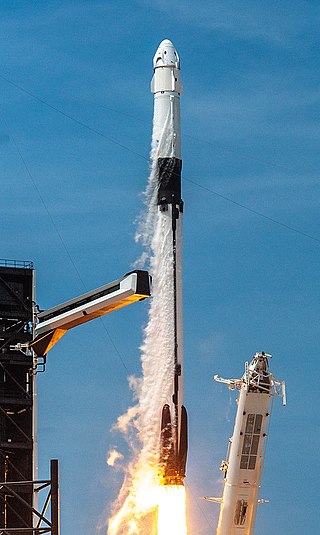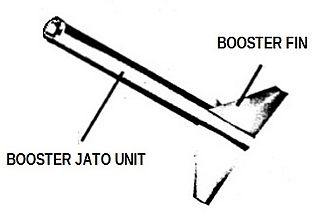Orión was the designation of a sounding rocket family of Argentina, which was launched between 1965 and 1971 at CELPA, CELPA, Tartagal and Wallops Island.

Orion is the designation of a small American sounding rocket. The Orion has a length of 5.60 meters, a diameter of 0.35 m, a launch weight of 400 kg, a launch thrust of 7 kN and a ceiling of 85 kilometers. The Orion, built by NASA Goddard Space Flight Center's Wallops Flight Facility, is also used as an upper stage of sounding rockets, usually paired with a Terrier missile as the first stage, although Nike, Taurus and VS-30 rockets are also used.

Strypi is a family of US re-entry vehicle test boosters, anti-missile targets and sounding rockets. They use a Castor first stage with two Recruit strap-on boosters, plus a range of upper stages. It is 31 inches in diameter, and has a maximum flight height of 124 miles.

The Poker Flat Research Range (PFRR) is a launch facility and rocket range for sounding rockets in the U.S. state of Alaska, located on a 5,132-acre (20.77 km2) site at Chatanika, about 30 miles (50 km) northeast of Fairbanks and 1.5 degrees south of the Arctic Circle. More than 1,700 launches have been conducted at the range to study the Earth's atmosphere and the interaction between the atmosphere and the space environment. Areas studied at PFRR include the aurora, plasma physics, the ozone layer, solar proton events, Earth's magnetic field, and ultraviolet radiation. Rockets launched at PFRR have attained an apogee of 930 miles (1,500 km).

ASP is the designation of an American sounding rocket family. ASP was used for a variety of uses, including research into hypersonic speed and to propel rocket sleds. In NASA service it was flown from a number of locations as a sounding rocket. The selection by NASA of the Apache and Javelin rockets for the jobs performed by ASP led to its retirement.

The Minotaur is a family of United States solid-fuel launch vehicles repurposed from retired Minuteman and Peacekeeper model intercontinental ballistic missiles. Built by Northrop Grumman under the Space Force's Rocket Systems Launch Program, these vehicles are used for various space and test launch missions.
The Mesquito is an American sounding rocket vehicle developed for the NASA Sounding Rocket Program on Wallops Island, Virginia. The Mesquito was developed to provide rocket-borne measurements of the mesospheric region of the upper atmosphere. An area of great science interest is in the 82–95 km region, where the conventional understanding of atmospherics physics is being challenged.
Taurus Nike Tomahawk, or TNT for short, is a sounding rocket which was first built in 1983. When it was in operation it was used to explore the upper atmosphere.

The Minotaur I, or just Minotaur is an American expendable launch system derived from the Minuteman II missile. It is used to launch small satellites for the US Government, and is a member of the Minotaur family of rockets produced by Orbital Sciences Corporation.
The Conestoga was a launch vehicle design funded by Space Services Inc. of America (SSIA) of Houston, Texas. Conestoga originally consisted of surplus LGM-30 Minuteman stages with additional strap-on boosters, as required for larger payloads. It was the world's first privately funded commercial rocket, but was launched only three times between 1981 and 1995, before the program was shut down.

The Sandhawk was a sounding rocket developed by Sandia National Laboratories in 1966. This single-stage, sub-orbital rocket had a mass of 700 kg, a takeoff thrust of 80 kN, and could reach heights of around 200 km. Sandia launched eight of these rockets between 1966 and 1974 as part of experiments conducted for the United States Atomic Energy Commission. About 25% of the launches failed.

This comparison of orbital launch systems lists the attributes of all current and future individual rocket configurations designed to reach orbit. A first list contains rockets that are operational or have attempted an orbital flight attempt as of 2024; a second list includes all upcoming rockets. For the simple list of all conventional launcher families, see: Comparison of orbital launchers families. For the list of predominantly solid-fueled orbital launch systems, see: Comparison of solid-fueled orbital launch systems.
Scout X-2 was an American expendable launch system and sounding rocket which was flown twice in 1962. It was a four-stage rocket, based on the earlier Scout X-1, uprated first and third stages. It was a member of the Scout family of rockets.
The Cajun was an American sounding rocket developed during the 1950s. It was extensively used for scientific experiments by NASA and the United States military between 1956 and 1976.

SPARK, or Spaceborne Payload Assist Rocket - Kauai, also known as Super Strypi, is an American expendable launch system developed by the University of Hawaii, Sandia and Aerojet Rocketdyne. Designed to place miniaturized satellites into low Earth and Sun-synchronous orbits, it is a derivative of the Strypi rocket which was developed in the 1960s in support of nuclear weapons testing. SPARK is being developed under the Low Earth Orbiting Nanosatellite Integrated Defense Autonomous System (LEONIDAS) program, funded by the Operationally Responsive Space Office of the United States Department of Defense.
The Star is a family of US solid-propellant rocket motors originally developed by Thiokol and used by many space propulsion and launch vehicle stages. They are used almost exclusively as an upper stage, often as an apogee kick motor. The number designations refer to the approximate diameter of the fuel casing in inches.

The Nike Smoke was a sounding rocket, part of a research project on the behavior of the horizontal winds in the upper atmosphere, developed by NASA in the 1960s based on the Nike booster. The goal was to obtain more accurate data on the behavior of these winds in order to guide the design of new vehicles particularly the Saturn family of vehicles.

The Nike stage or Nike booster, a solid fuel rocket motor, was developed by Hercules Aerospace for use as the first stage of the Nike Ajax and Nike Hercules missiles as part of Project Nike.

Explorer S-56 was a NASA satellite launched on 4 December 1960, at 21:14 GMT as part of the Explorer program. The satellite was composed of a 3.66 m (12.0 ft) diameter inflatable sphere, and was intended to study the density of the upper atmosphere. The Scout X-1 rocket used to launch Explorer S-56 failed in flight, and the satellite never reached orbit.
Nike Yardbird was an American sounding rocket with two stages, based upon the Nike Hercules M5E1 booster and a Thiokol TE-289 Yardbird upper stage. Yardbird was an improved Thiokol XM-19 motor. The Nike Yardbird was launched 2 times from Wallops Island on Sphere Test aeronomy missions both of which were classified as failures. Information available does not state the reason for the mission failures but Astronautix lists the apogee of both missions as 10 km (6 mi) which is well below the goal of 120 km (70 mi).












